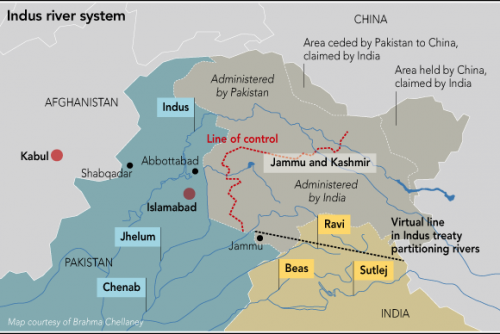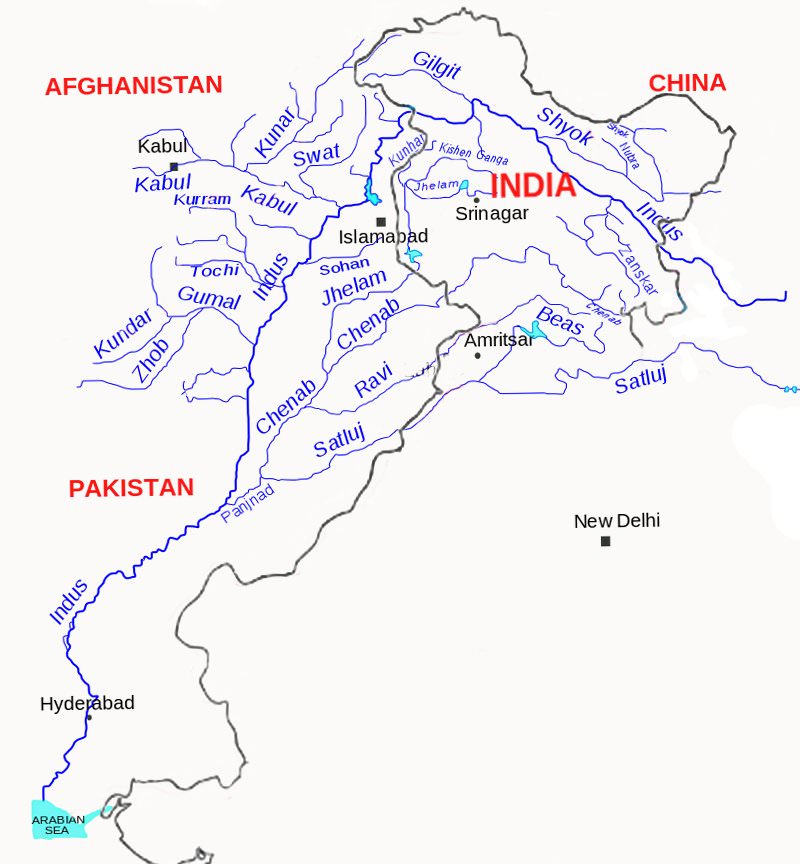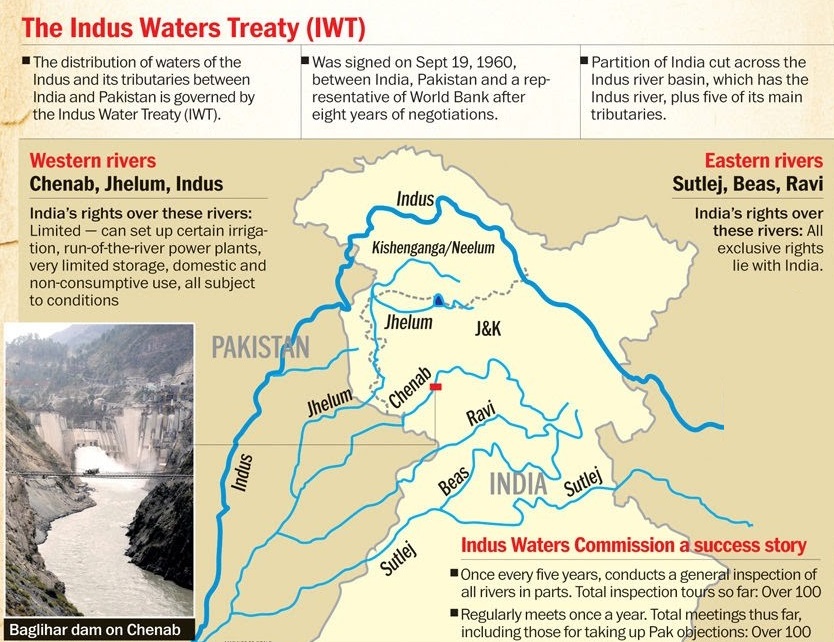Indus Water Treaty
2022 MAR 2
Mains >
International relations > India and Neighbours > water management

IN NEWS:
- The annual meeting of the Permanent Commission on Indus Waters (PCIW) is being held at Islamabad and the two sides are expected to discuss among other topics arrangements about flood flow information during the current season and finalise future programmes, meetings and inspections.
INDUS RIVER SYSTEM:
- The Indus, also known as the Sindhu, is the westernmost of the Himalayan rivers in India.
- It originates from a glacier near Bokhar Chu in the Tibetan region in the Kailash Mountain range. In Tibet, it is known as ‘Singi Khamban’ or Lion’s mouth.
- Tributaries:
- Left bank : Shyok, Zanskar, Jhelum, Chenab, Ravi, Beas and Sutlej
- Right bank : Khurram, Tochi, Gomal, Viboa, Sangar, Kabul, Suru

- The Panjnad is the name given to the five rivers of Punjab, namely the Satluj, the Beas, the Ravi, the Chenab and the Jhelum.
INDUS WATER TREATY:
- The Indus Waters Treaty (IWT) between India and Pakistan, brokered by the World Bank, dictates the terms of using the water available in the Indus River and its tributaries.
History:
- Partitioning the Indus rivers system was inevitable after the Partition of India in 1947.
- During the first years of partition, the waters were apportioned by the Inter-Dominion Accord of May 4, 1948. This accord required India to release sufficient waters to the Pakistan in return for annual payments from Pakistan.
- In 1951, David Lilienthal, former chairman of the Tennessee Valley Authority and of the U.S. Atomic Energy Commission, visited the region and suggested that the World Bank might use its good offices to bring the parties to agreement. This suggestion was accepted by all parties.
- After 9 years of negotiation mediated by the World Bank, the final treaty was signed in Karachi on 19 September 1960 by Pandit Jawaharlal Nehru and Ayub Khan.
Agreement:
- The Treaty gives control over the waters of the three "eastern rivers" — the Beas, Ravi and Sutlej to India and the three "western rivers" — the Indus, Chenab and Jhelum to Pakistan.
- Thereby, India conceded 80.52 per cent of the aggregate water flows in the Indus system to Pakistan.
- But India can use 20% of the water in western rivers in “non-consumptive” needs, such as for irrigation and electricity production.

- The Permanent Indus Commission is a bilateral commission of officials from India and Pakistan, created to implement and manage goals of the Indus Waters Treaty.
- An Indus Basin Development Fund Agreement, a treaty between Australia, Canada, West Germany, New Zealand, the United Kingdom, the United States with the World Bank and Pakistan was also signed, which agreed to provide Pakistan a combination of funds and loans for the construction of canals and storage facilities.
- India also gave Rs 83 crore in pounds sterling to Pakistan to help build replacement canals from the western rivers.
SIGNIFICANCE OF THE TREATY FOR INDIA:
- Peaceful coexistence:
- The treaty has managed to survive even after three wars (1965, 1971 and 1999), a number of military stand-offs (1987, 2001-02, 2008, 2016 and 2019) and several other episodes of political friction between the nuclear rivals. Thus, it clearly highlights that India and Pakistan can peacefully coexist in the region.
- Major projects:
- India has constructed major projects like the Bhakra Dam on Satluj, Pong and Pandoh Dam on Beas and Thein (Ranjit sagar) on Ravi. All of them are vital for the prosperity of North west India.
- Responsible upper riparian:
- The role of India as a responsible upper riparian abiding by the provisions of the treaty has been remarkable. This has indirectly benefited India in concluding other water sharing agreements, like 1996 Ganges Treaty with Bangladesh.
- Strategic advantage:
- Being the upper riparian, India derives significant military advantage out of IWT. It can act as a strategic pressure point in the events of bilateral disputes.
- Military advantage:
- Since Indus is the lifeline of Pakistan, they will be hesitant to initiate any attack in the event of a conflict. Also, Pak attacks on dams or power stations located in Indian part of Indus system will become a violation of the IWT and can lead to its abrogation.
CHALLENGES TO THE TREATY:
- Under-utilisation:
- Out of the total estimated capacity of 11406 MW electricity that can be harnessed by India in Kashmir, only 3034 MW has been tapped so far. Further, available data suggests that around 10% of India’s share lies unused and is allowed to flow into Pakistan.
- Recurring disputes:
- To utilise the full potential of Ravi water, the Centre is currently taking three steps - resumption of construction of Shahpurkandi project; construction of Ujh multipurpose project; and a second Ravi-Beas link below Ujh. However, the construction has been frequently interrupted by Pakistan’s objections.
- New realities:
- The variations in hydrology of rivers, rainfall patterns glacial melting due to climate change has altered the flow of the rivers. The basins are largely becoming deficit in water and hence conflicts are frequently arising.
- Water nationalism:
- In recent years, due to widening supply-demand gap and increasing tensions between the two countries, there has been calls to utilize all the waters and the abrogation of the treaty.
- Pak sponsored terror:
- India is under pressure to rethink the IWT, as its overall political relations with Pakistan becomes intractable following Pakistan’s cross-border terrorism and intransigence.
- Affects other neighbourhood relations:
- Any unilateral changes to IWT will send alarm bells ringing in India’s other lower riparian country, Bangladesh which receives about 91% of its waters from the rivers flowing from India.
- China-Pak nexus:
- The growing collaboration between Pakistan and China on security, economy and water projects, primarily on the western flowing rivers of IRS, may lead the Chinese to become much more assertive towards India.
- No exit clause:
- The treaty has no provision for either country unilaterally walking out of the pact. Even the severance of diplomatic and consular relationships between India and Pakistan cannot terminate the IWT.
CONCLUSION:
- Despite the treaty lacking an exit clause, provisions of the 1969 Vienna Convention provide certain rights for lower riparian states. It can also hamper the country’s image internationally. Hence, it is not advisable for India to exit the treaty.
- Instead of contemplating abrogation or finding faults with the IWT, India and Pakistan can explore it for mutual benefits. For example, Article VII of the IWT talks about future cooperation and calls for taking up joint studies and engineering works on the rivers.
- India’s best option would be to optimise the provisions of the treaty. For this, India has to speed up its construction projects that have been pending for long.
PRACTICE QUESTION:
Q. While it may have served some purpose at the time it was signed, new realities call for a relook into the Indus Water Treaty. Discuss?


